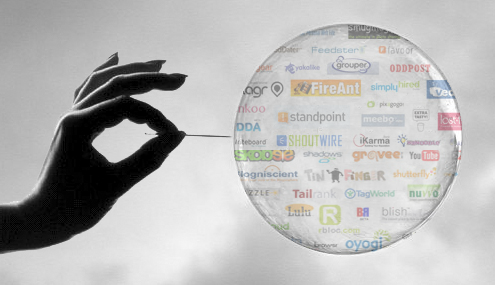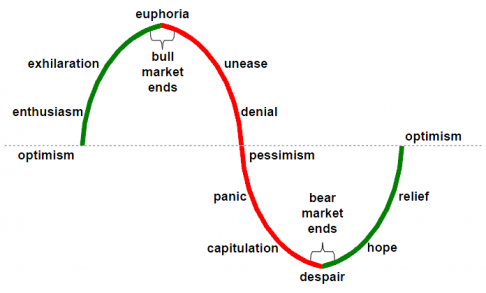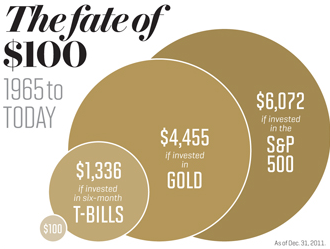Currency
 Late in the life of every financial bubble, when things have gotten so out of hand that the old ways of judging value or ethics or whatever can no longer be honestly applied, a new idea emerges that, if true, would let the bubble keep inflating forever. During the tech bubble of the late 1990s it was the “infinite Internet.” Soon, we were told, China and India’s billions would enter cyberspace. And after they were happily on-line, the Internet would morph into versions 2.0 and 3.0 and so on, growing and evolving without end. So don’t worry about earnings; this is a land rush and “eyeballs” are the way to measure virtual real estate. Earnings will come later, when the dot-com visionaries cash out and hand the reins to boring professional managers.
Late in the life of every financial bubble, when things have gotten so out of hand that the old ways of judging value or ethics or whatever can no longer be honestly applied, a new idea emerges that, if true, would let the bubble keep inflating forever. During the tech bubble of the late 1990s it was the “infinite Internet.” Soon, we were told, China and India’s billions would enter cyberspace. And after they were happily on-line, the Internet would morph into versions 2.0 and 3.0 and so on, growing and evolving without end. So don’t worry about earnings; this is a land rush and “eyeballs” are the way to measure virtual real estate. Earnings will come later, when the dot-com visionaries cash out and hand the reins to boring professional managers.
During the housing bubble the rationalization for the soaring value of inert lumps of wood and Formica was a model of circular logic: Home prices would keep going up because “home prices always go up.”
Now the current bubble – call it the Money Bubble or the sovereign debt bubble or the fiat currency bubble, they all fit – has finally reached the point where no one operating within a historical or commonsensical framework can accept its validity, and so for it to continue a new lens is needed. And right on schedule, here it comes: Governments with printing presses can create as much currency as they want and use it to hold down interest rates for as long as they want. So financial crises are now voluntary. They only happen if a country decides to stop depressing interest rates – and why would they ever do that? Here’s an article out of the UK that expresses this belief perfectly:
….more HERE plus Commentary


NEW YORK (Reuters) – Short-seller Jim Chanos said Tuesday it is time for typical equity investors to be “a little more cautious” even as the stock market may continue to rise.
Chanos, speaking the Reuters Global Investment Outlook Summit in New York said his fund Kynikos Associatesis “very bearish on coal” and he is “pretty much short” all the U.S. leveraged coal companies.
Chanos also said he was bearish on national oil companies and the integrated majors like Exxon-Mobil, which he said are experiencing a “dropping return on capital” that “is really ominous.”
The famous short-seller said Exxon-Mobil and other oil companies like it increasingly look like “value trap.”
He also said investors would be “well warned” to analyze Caterpillar Inc’s financial unit.
This post originally appeared at Reuters. Copyright 2013.

 90yr Old Richard Russell: “Imprint today’s stock market action firmly in your mind because I believe we are going to see an explosion in stocks beyond anything ever seen before. Something has taken over the minds of both retail investors and institutional managers.
90yr Old Richard Russell: “Imprint today’s stock market action firmly in your mind because I believe we are going to see an explosion in stocks beyond anything ever seen before. Something has taken over the minds of both retail investors and institutional managers.
In a sentence, the psychology now is — “you’re a pathetic sap if you’re not in this stock market.” The Fed is fighting a semi-depression, and Janet Yellen, if anything, is ready to throw more logs on the fire.
In today’s New York Times, Paul Krugman notes that Larry Summers calls the current depressed and deflationary economy “the new normal.” The only thing that will keep it from sinking into genuine depression is occasional bouts of bubbles. And a bubble in stocks we are now in.
Most investors who are in this market are convinced that they can exit the market in a timely fashion if or when this world bull market breathes it’s last. Lucky is the stout investor who does not need this market. Warren Buffett reveals that he bought over three billion dollars worth of Exxon. What the hell, If Exxon goes broke it will be the end of capitalism in the US. Good thinking, Warren.
But remember there’s only one asset class that can’t go broke, and it’s gold.
………………………………….
Like some unstoppable medieval monster, the Dow continues to march due North, confirmed by the Transports. There’s no return for investors in cash, there’s no return in bonds, which leaves the best blue-chip stocks the only profitable game in town.
And when does it end? That’s the other guessing game in town. Hedge and pension fund managers are afraid to get off the train too soon. If they leave the game, where will they go? The only choice — stay with the big blue-chip industrials, and play the same game everybody else is playing.
In the meantime, asset prices are sky-rocketing. At the art auctions, pieces are selling for record prices. Money has become a fantasy item. Everything is appraised in billions of dollars. Madness reigns as the Fed spews out a trillion dollars in new money annually.
Ironically, gold lags behind. But when gold finally catches on, it will make up for lost time. Meanwhile the Government churns out happy and optimistic statistics. We may well be heading into the greatest bull market climax in recorded history.
… I’ve been writing Dow Theory Letters ever since 1958 with never skipping a mailing or taking a vacation.
But now as I’m approaching the age of 90, I find that I have to conserve my ebbing energy … I’m going to reveal to you Emmet Fox’s marvelous “Golden Key.” If you have any kind of problem, a court case, a marital fight or a financial bind, this is the great “Golden Key” that will solve all your problems.
When the problem presents itself, turn away from it, put it out of your mind completely and think of something that pertains to God, such as God is love or God is truth, but you must keep the problem completely out of mind. This is the simple Golden Key which the great Emmet Fox recommends. It may sound too absurdly simple, it may sound like voodoo, but before you sneer at it and ignore it, first try it. I’ve used it many times and I can tell you that it works. The concept of the Golden Key is probably worth years of subscriptions to Dow Theory Letters. Use the Golden Key.
Late Notes — More of the same. The Dow pushing up towards a third phase climax and gold continuing to creep out of its huge base. If you have stocks or gold, your job now is to sit and watch. I believe a historic climax is not far away … History will be made over the coming 12 months.”
Kingworld News Note: Russell concluded with this astonishing and important quote from Janet Yellen which reveals the true reality of the Fed and its secretive nature:
“In 1977, when I started my first job at the Federal Reserve Board as a staff economist in the Division of International Finance, it was an article of faith in central banking that secrecy about monetary policy decisions was the best policy: Central banks, as a rule, did not discuss these decisions, let alone their future policy intentions.” Janet Yellen
To subscribe to Richard Russell’s Dow Theory Letters CLICK HERE.














